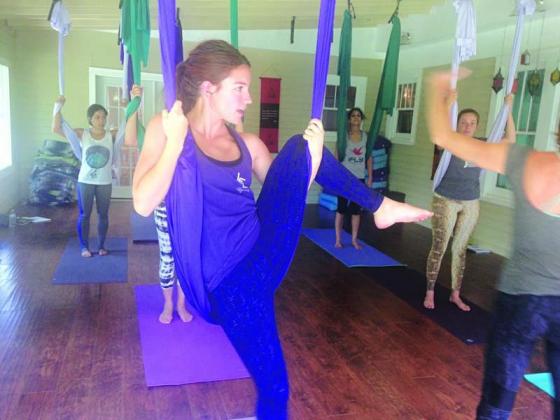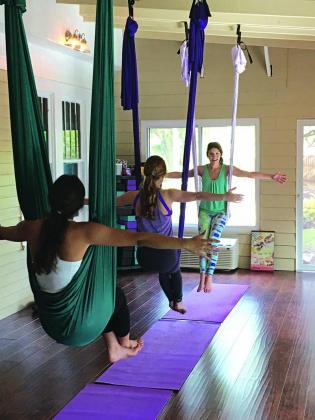

By William Taylor Potter
Manship School News Service
For Allyson Huval, the closer her head is to the ground the more alive she feels.
Huval, an LSU freshman from Lafayette, is an instructor for aerial and hammock yoga. Aerial yoga is a technique that involves performing yoga poses and dance moves while suspended on a silk hammock.
The studio where Huval teaches, The Yoga Garden in Lafayette, started offering aerial yoga classes in April 2015.
Alisha Bourque, another instructor with The Yoga Garden, said some ballet studios in Lafayette and several aerialists from the Baton Rouge and New Orleans areas have been practicing the new yoga form for a couple of years.
“It is still very upcoming,” Huval said. “In (many) big cities, they have a lot of aerial yoga, but in the smaller cities down South it’s not as popular.”
Huval started taking the class in April 2015, and said she was “absolutely terrible” in the beginning. By spring break, she was teaching other teenagers. She said it took time before she completely trusted the silk to hold her, but she was hooked after the first class.
“I wanted just to keep going. My first class was very beginner and very simple. I don’t even teach that simple of classes whenever I drive 45 minutes away to teach.”
Huval is in the process of becoming a trainer, and is on pace to get her certification by December. She’s talking a class at LSU in aerial silks, which is a performance art that involves dancing and posing on long, vertical pieces of silk.
Bourque said Louisiana is still more of the aerial art scene, while aerial yoga is still gaining popularity. She said the yoga form is more accessible to the common person and isn’t as risky as performing on aerial silk.
“Anyone can do it,” Bourque said. “Anyone who has practiced yoga, or maybe has known about yoga, they can try it for the first time and take some risks with it.”
The practice has several health benefits, Bourque said. She said some places in Atlanta, Georgia, are using aerial yoga for disabled children and to help those with disabilities to improve their balance.
In an interview with Shape.com in August, Allan Stewart, director of aortic surgery at Mount Sinai Hospital in New York City, said the yoga could ease painful symptoms of back spasms, scoliosis or a herniated disk.
Inversions, or moves that require hanging upside down, help decompress the spine and create space in the body, Bourque said. She said her favorite moves involved flipping forward or backward, including moves called “skin the cat” and “vampire.”
Huval said she’s not a big fan of climbing on the silks or doing the intricate tricks. For the most part, she simply loves to hang upside down.
One of her favorite moves, straddleback, involves wrapping the silk around the sacrum area, which is between the bottom of the spine and the tailbone. In this pose, she would be flipped upside down with legs would be spread.
She said her class at LSU recently learned ankle-hangs, which Huval said is exactly like it sounds.
While the prospect of being flipped upside down, supported only by strands of silk would be of concern to most, this is where Huval is most comfortable.
“Honestly, if my head is closest to the ground, that’s the way I like it,” Huval said. “I like just being deadweight.”
